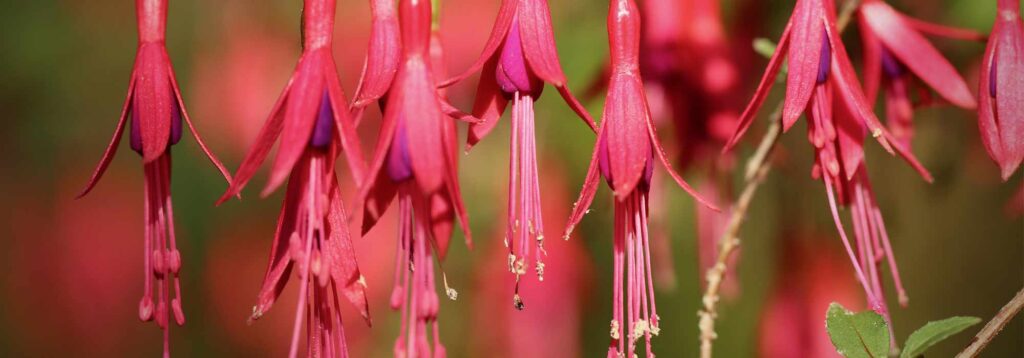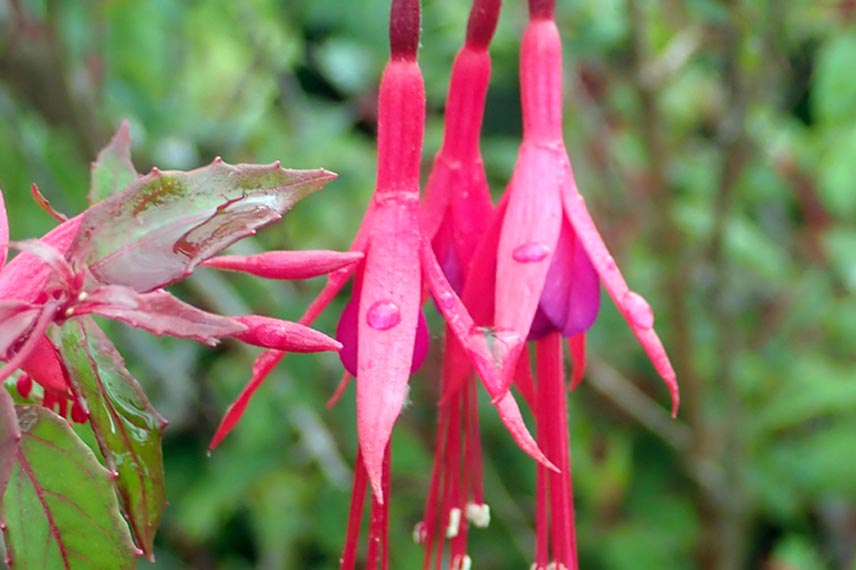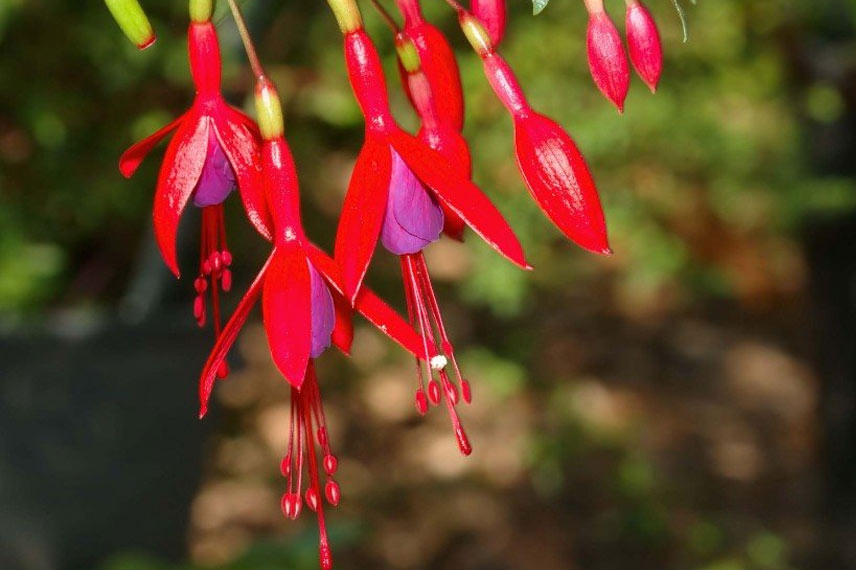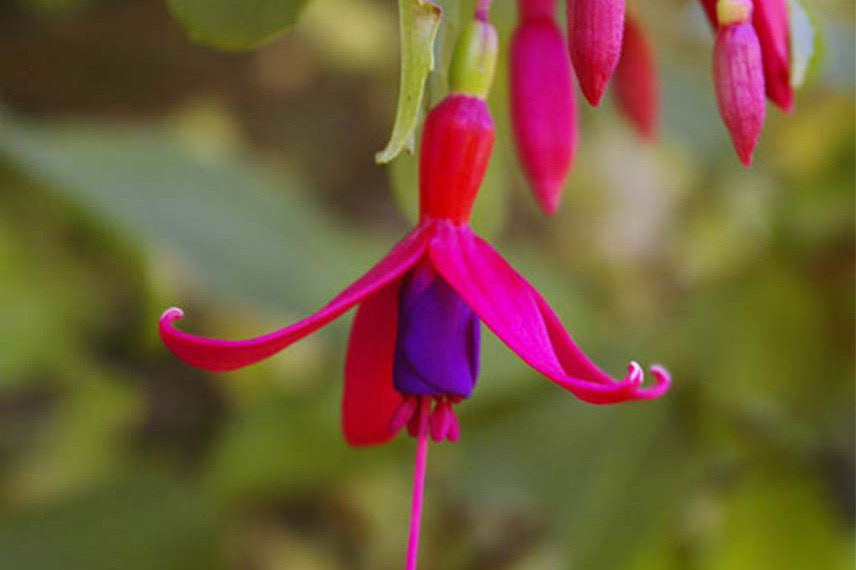
When talking about hardy fuchsia, it is important to classify it into two very distinct categories. Indeed, some fuchsias considered to be hardy are able to resist the cold , but they have difficulty starting up again and blooming again at the end of winter. Conversely, some species resist the cold well and are then able to start growing again easily before flowering abundantly.
Here is our selection of the 6 most hardy and reliable fuchsia species.
FUCHSIA MAGELLANICA: THE HARDIEST!
Fuchsia magellanica is a shrubby plant with good hardiness . It is even the hardiest Fuchsia there is, since it is able to withstand temperatures of around -15°C. Perennial, Magellanic Fuchsia forms a dense bush of small oval leaves. It produces (from July to October) hanging flowers, fine and fragrant, with red sepals and purple petals.

Growing Magellanic Fuchsia
Grown in the garden, Fuchsia magellanica is used in shaded borders. It is planted in March or September, in moist, cool soil (not completely drying out in summer). The shrub likes fertile, well-drained soils and continuously humid atmospheres. In mild climates, where there is little or no frost, its stems are folded down by half to obtain a denser silhouette. In harsh climates , on the other hand, with frosts above -15°C, cut back the stems to 10 cm from the ground and protect the stump by mulching it or hilling it up.
Some varieties of hardy Fuchsias magellanica
Among the many varieties of Fuchsias magellanica (thousands have been created through crossbreeding), some particularly deserve your interest for their hardiness and ornamental qualities.
- Fuchsia magellanica var. gracilis and its beautiful flowering in bells with particularly dense colours. Installed in cool soil, it favors a shady position or subdued light, and can withstand non-burning sun.
- Le Fuschia magellanica var. arauco and its small flowers with pinkish red tubes, white sepals and purple corollas. Easy to grow, it enjoys sunny, semi-shady situations as well as fresh, well-drained soils.
- Le Fuchsia magellanica var. molinae and its beautiful pink-shaded white flowers. It is grown in shady conditions, where it thrives easily in bushes.
FUCHSIA REGIA ‘REITZII’: A LONG TWO-TONE BLOOM
Fuchsia regia ‘ Reitzii’ is one of the hardiest shrub species , with a hardiness of around -10 to -12°C. It is also the most cultivated variety for ornamental gardens. A vigorous, almost climbing plant, it has semi-evergreen foliage (down to -5°C) and vining branches. This magnificent fuchsia is especially appreciated for its long two-tone flowering (August to November). Its small red and purple flowers with curved sepals then give way to small edible berries offering a purplish black color.

Growing Royal Fuchsia
A vigorous variety, Fuchsia regia ‘Reitzii’ is planted in spring (March and April), or at the end of summer (September). It likes oceanic climates, light shade, and cool, light soils. Prune the stems by half in the spring in mild climates to maintain a compact habit. Elsewhere, prune the stems in the fall and protect the stump by mulching or earthing it up. An annual pruning after flowering stimulates its growth and flowering the following year. Fuchsia regia ‘Reitzii’ survives cold winters by springing back from the stump the following spring.
FUCHSIA ‘ALICE HOFFMAN’: MANY SMALL RED AND WHITE FLOWERS
Fuchsia ‘ Alice Hoffman’ is an old variety appreciated for its floridity and its good resistance to cold. It is indeed hardy down to -11°C. This sprightly little shrub forms a bushy, slightly drooping bush. It has abundant, deciduous foliage composed of narrow, lanceolate dark green leaves. Its flowering (from June to September-October) offers a multitude of small flowers in red and white bells which are renewed throughout the beautiful season.

Growing Hardy Fuchsia ‘Alice Hoffman’
The Fuchsia ‘Alice Hoffman’ is grown in the ground, or in a large pot, in shade or semi-shade. This hybrid and old variety likes fertile, light and well-draining substrates. During the growth period, it appreciates being fed every 15 days with a fertilizer for Fuchsias. Regularly rid it of its faded flowers and dry leaves. Cut it back in the fall after flowering. Hardy down to -6°C without any protection, it is able to withstand frosts down to -11°C if it is sheltered in winter.
FUCHSIA ‘MRS POPPLE’: LARGE RED AND PURPLISH-PURPLE BELLS
Fuchsia ‘Mrs Popple’ is a bushy shrub with upright branches, hardy down to -10°C. An old variety, it has deciduous foliage composed of dark green leaves. Particularly appreciated for its abundant flowering, the hardy Fuchsia ‘Mrs Popple’ produces a quantity of large, bell-shaped, scarlet-red and purplish-purple flowers, which are renewed until late in the season (from June to October).

Growing Fuchsia ‘Mrs Popple’
Vigorous, the Fuchsia ‘Mrs Popple’ is grown in the ground or in a large pot. It is preferably planted in March. It appreciates fertile, fresh and well-drained soils, as well as semi-shaded to shady situations. This Fuchsia can be grown in outdoor beds, or in greenhouses and verandas, and should be watered regularly but not excessively in times of drought. In cold climates, put it away for the winter. Elsewhere, lower it to 15 cm from the ground in autumn and cover it with a thick mulch of dead leaves or fern fronds, all wrapped in a winter veil or covered with a waterproof tarpaulin.
FUCHSIA ‘BLUE SARAH’: WHITE COROLLAS AND MAUVE PETTICOAT
Fuchsia ‘ Blue Sarah’ is an upright shrub , capable of withstanding a temperature of -10°C provided it is protected. Suspended among lustrous foliage resplendent with health, the two-tone flowers of this Fuchsia x hybrida are dressed in a mauve , double and rustling petticoat, surmounted by a white corolla. This abundant and spectacular flowering lasts until late in the season, stretching from June to October.

Growing Fuchsia ‘Blue Sarah’
Easy to grow , the Fuchsia ‘Blue Sarah’ can be installed in the garden, in a flowerpot or in suspension. It is planted from March to May, in sunny, semi-shaded or shady exposure, in fertile, drained and cool soil. During the growth period, the plant needs to be fed every 15 days using a liquid fertilizer for fuchsias. The shrub also needs to be cut back in the fall, after flowering. The hardiness of Fuchsia ‘Blue Sarah’ reaches -5°C without any protection. A resistance to cold which can go down to -10°C if the plant is suitably sheltered .
FUCHSIA ‘GENII’: FUCHSIA PINK AND PURPLE FLOWERS
Fuchsia ‘ Genii’ is an old and shrubby variety with a compact habit, appreciated for its hardiness of around -10°C. This beautiful sprightly shrub has very bright foliage composed of narrow, deciduous leaves of a green color tinged with yellow. It blooms from June to September and produces abundant amounts of small, bi-coloured fuchsia pink and purple bell-shaped flowers .

Growing Fuchsia ‘Genii’
Fuchsia ‘Genii’ grows in a rich, fresh and well-drained substrate. It is planted in March in a shady or semi-shady location. It can be grown in the open ground in areas with mild winters, and it can be grown in a large pot for storage in cold climates. Its hardiness reaches -6 ° C without protection, and up to -10 ° C when sheltered. If it fears drought and needs to be watered regularly, Fuchsia ‘Genii’ can’t stand stagnant water .

